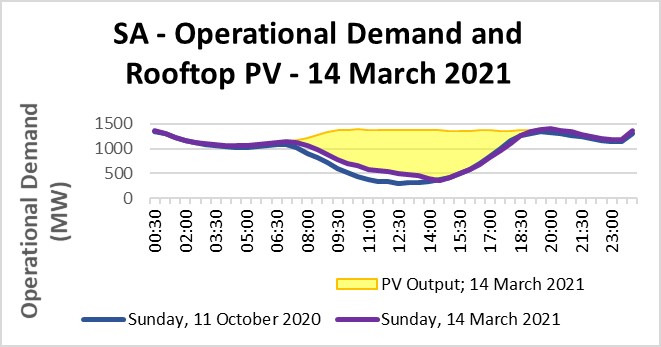On Sunday afternoon, South Australia experienced near-record minimum demand levels for electricity from the grid. This was due to mild weather conditions, low energy needs from industry and large volumes of surplus electricity from rooftop solar passively feeding into the power system.
At the same time, a week-long planned outage on one of the high-voltage powerlines feeding the Victoria to South Australia interconnector was taking place, permanently restoring the transmission towers damaged from extreme weather conditions in January 2020.
AEMO anticipated this minimum demand event and issued a market notice early Sunday morning forecasting insufficient demand levels below the 400 megawatts (MW) threshold. AEMO’s studies have shown that the secure scheduled demand threshold is 400 MW when SA is at risk of islanding, which was the case at this time due to the network outages.
Despite AEMO taking steps to reduce synchronous generation and large-scale renewable generators while maintaining system security, minimum operational demand fell to 358 MW, just shy of the 300 MW record set on 11 October 2020.
Due to the combination of these circumstances, to retain system security, AEMO directed South Australia’s transmission owner and operator, ElectraNet, to take steps to maintain grid-demand above 400 MW for about an hour from 3:00pm (ACDT).
This resulted in curtailing a range of larger distribution-connected solar generation and residential solar customers, including more than 10 MW for the first time through the South Australian Government’s ‘Smarter Homes’ initiatives.
In early 2020, the South Australian Government’s ‘Smarter Homes’ program set new requirements for small business and residential solar PV installations, effective from 28 September 2020. This mandated that consumers installing or replacing rooftop solar PV assign an agent to curtail generation in rare events threatening the security of the NEM.
These requirements were part of a suite of new initiatives recommended by AEMO following detailed analysis commissioned by the South Australian Government, which outlined the current operational challenges caused by the rapid increase of commercial and residential solar PV in South Australia, including minimum operational demand.
System security concerns due to minimum operational demand are likely to become more common in other jurisdictions as the uptake of household and commercial solar PV continues at record pace. At the time, wholesale electricity prices were in the range of -$500 per megawatt hour.
In total, 67 MW of solar PV was curtailed through South Australia Power networks across the period of about an hour through a range of mechanisms outlined below.
-
17 MW of commercial solar PV curtailed through SCADA control systems
-
More than 10 MW of distributed solar PV curtailed through registered agents (Smarter Homes)
-
40 MW of rooftop solar PV curtailed through enhanced voltage management at seven substations
AEMO has been and continues to work with governments, government agencies, market bodies and consumers to support the development of a range of measures that seeks to enable greater amounts of renewable energy in the NEM and maximise consumer benefits.
This includes establishing Australia’s first DER register, conducting engineering studies, trials and modelling to effectively integrate DER, and enhance inverter standards, market reforms and regulations. Click here to visit AEMO’s DER Program.
In addition, AEMO, is contributing to the Energy Security Board’s (ESB) post 2025 energy reforms, aimed at progressing a modern regulatory structure which will better support innovative market response to these situations.
In January 2021, a directions paper was published by the EBS outlining four reforms which are addressing almost all aspects of how electricity is generated and dispatched, how consumers can access the services they want and how investment can occur in the most efficient way to avoid unnecessary costs.
The ESB will advise Energy Ministers by mid-2021 on changes to the existing market design, or recommend an alternative market design, to enable the provision of the full range of services to customers necessary to deliver a secure, reliable and lower emissions electricity system at least-cost.







